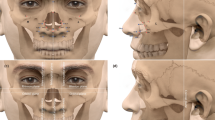Abstract
Purpose
The Frankfurt line is the most frequently and widely used reference line in cephalometric analysis, but has shortcomings including the difficulty of landmark identification. This study investigated using the superior border of the zygomatic arch as a new external bony landmark, including measuring the angle between the new reference line and the Frankfurt line.
Methods
Facial computed tomography scans were obtained from 170 patients (100 males and 70 females) hospitalized at Konkuk University Chungju Hospital. After three-dimensional reconstruction, the locations of the porion and the inferior orbital rim and the superior border of the zygomatic arch were identified twice by two observers using software. A horizontal line parallel to the superior border of the zygomatic arch was established. The angle between the Frankfurt line and new reference line was then measured on each side.
Results
There was no significant intraobserver or interobserver bias. The angle between the Frankfurt line and the superior border of the zygomatic arch was 4.5° ± 2.5° (mean ± SD), and it was somewhat larger in females than males, but the difference was not statistically significant.
Conclusions
This study demonstrated the good reproducibility of the location of the superior border of the zygomatic arch and found that the angle between the new reference line and the Frankfurt line is relatively constant. The superior border of the zygomatic arch therefore has potential as an alternative reference line to the Frankfurt line in specific clinical applications and anthropological studies, since it is a more accessible bony landmark on the external skull.



Similar content being viewed by others
References
Bergersen EO (1980) Enlargement and distortion in cephalometric radiography: compensation tables for linear measurements. Angle Orthod 50:230–244. https://doi.org/10.1043/0003-3219(1980)050%3C0230:EADICR%3E2.0.CO;2
Chaconas SJ, Fragiskos FD (1991) Orthognathic diagnosis and treatment planning: a cephalometric approach. J Oral Rehabilit 18:531–545
Durao AR, Pittayapat P, Rockenbach MI, Olszewski R, Ng S, Ferreira AP, Jacobs R (2013) Validity of 2D lateral cephalometry in orthodontics: a systematic review. Prog Orthod 14:31. https://doi.org/10.1186/2196-1042-14-31
Hassan B, Nijkamp P, Verheij H, Tairie J, Vink C, van der Stelt P, van Beek H (2013) Precision of identifying cephalometric landmarks with cone beam computed tomography in vivo. Eur J Orthod 35:38–44. https://doi.org/10.1093/ejo/cjr050
Houston WJ (1983) The analysis of errors in orthodontic measurements. Am J Orthod 83:382–390
Kattan EE, Kattan ME, Elhiny OA (2018) A new horizontal plane of the head. Open Access Maced J Med Sci 6:767–771. https://doi.org/10.3889/oamjms.2018.172
Ludlow JB, Gubler M, Cevidanes L, Mol A (2009) Precision of cephalometric landmark identification: cone-beam computed tomography vs conventional cephalometric views. Am J Orthod Dentofac Orthop 136:312 e311–310. https://doi.org/10.1016/j.ajodo.2008.12.018 (discussion 312–313)
Lundstrom A, Lundstrom F (1995) The Frankfort horizontal as a basis for cephalometric analysis. Am J Orthod Dentofac Orthop 107:537–540
Lundstrom A, Lundstrom F, Lebret LM, Moorrees CF (1995) Natural head position and natural head orientation: basic considerations in cephalometric analysis and research. Eur J Orthod 17:111–120
Olszewski R, Reychler H (2004) Limitations of orthognathic model surgery: theoretical and practical implications. Revue de stomatologie et de chirurgie maxillo-faciale 105:165–169
Olszewski R, Zech F, Cosnard G, Nicolas V, Macq B, Reychler H (2007) Three-dimensional computed tomography cephalometric craniofacial analysis: experimental validation in vitro. Int J Oral Maxillofac Surg 36:828–833. https://doi.org/10.1016/j.ijom.2007.05.022
Pittayapat P, Jacobs R, Bornstein MM, Odri GA, Lambrichts I, Willems G, Politis C, Olszewski R (2018) Three-dimensional Frankfort horizontal plane for 3D cephalometry: a comparative assessment of conventional versus novel landmarks and horizontal planes. Eur J Orthod 40:239–248. https://doi.org/10.1093/ejo/cjx066
Pittayapat P, Limchaichana-Bolstad N, Willems G, Jacobs R (2014) Three-dimensional cephalometric analysis in orthodontics: a systematic review. Orthod Craniofac Res 17:69–91. https://doi.org/10.1111/ocr.12034
Ricketts RM, Schulhof RJ, Bagha L (1976) Orientation-sella-nasion or Frankfort horizontal. Am J Orthod 69:648–654
Rossini G, Cavallini C, Cassetta M, Barbato E (2011) 3D cephalometric analysis obtained from computed tomography. Rev Lit Ann Stomatol 2:31–39
Schlager S, Rudell A (2017) Sexual dimorphism and population affinity in the human zygomatic structure-comparing surface to outline data. Anat Rec 300:226–237. https://doi.org/10.1002/ar.23450
Schlicher W, Nielsen I, Huang JC, Maki K, Hatcher DC, Miller AJ (2012) Consistency and precision of landmark identification in three-dimensional cone beam computed tomography scans. Eur J Orthod 34:263–275. https://doi.org/10.1093/ejo/cjq144
Toledo Avelar LE, Cardoso MA, Santos Bordoni L, de Miranda Avelar L, de Miranda Avelar JV (2017) Aging and sexual differences of the human skull. Plast Reconstr Surg Glob Open 5:e1297. https://doi.org/10.1097/GOX.0000000000001297
Tremont TJ (1980) An investigation of the variability between the optic plane and Frankfort horizontal. Am J Orthod 78:192–200
Williams SE, Slice DE (2010) Regional shape change in adult facial bone curvature with age. Am J Phys Anthropol 143:437–447. https://doi.org/10.1002/ajpa.21332
Author information
Authors and Affiliations
Corresponding author
Rights and permissions
About this article
Cite this article
Park, J.A., Lee, JS., Koh, KS. et al. Using the zygomatic arch as a reference line for clinical applications and anthropological studies. Surg Radiol Anat 41, 501–505 (2019). https://doi.org/10.1007/s00276-018-2162-6
Received:
Accepted:
Published:
Issue Date:
DOI: https://doi.org/10.1007/s00276-018-2162-6




